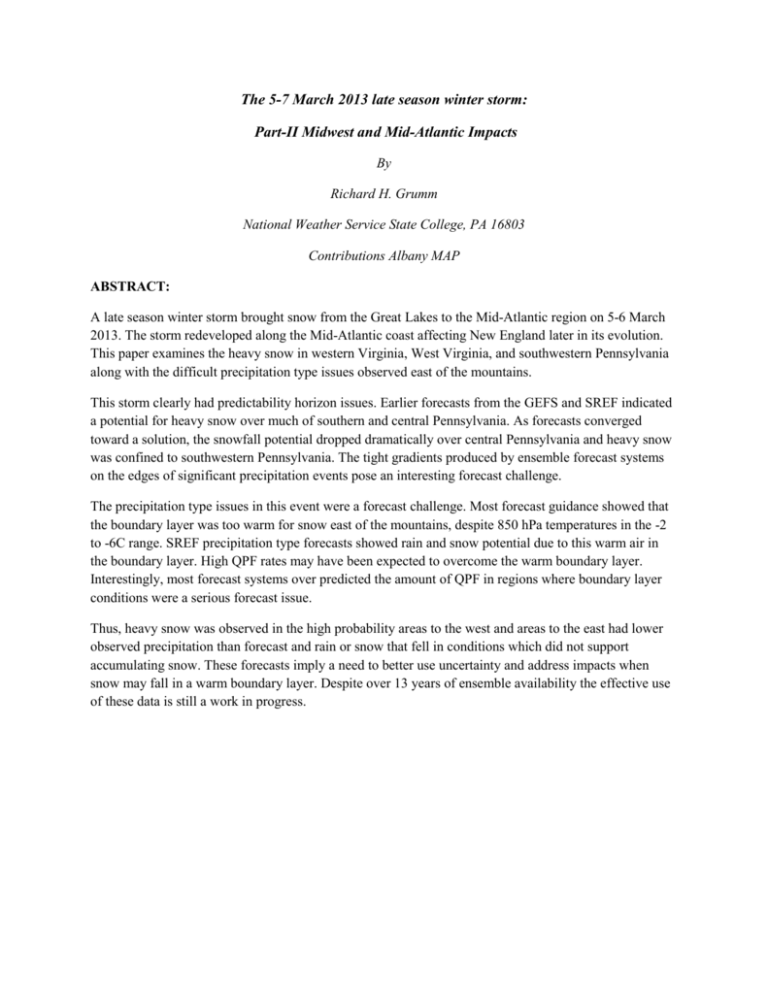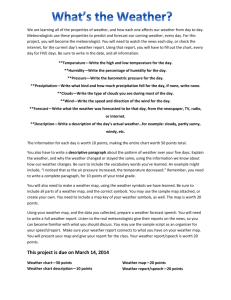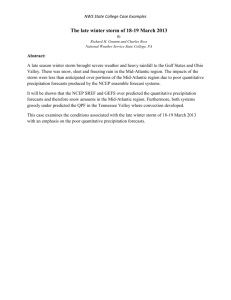06Mar2013
advertisement

The 5-7 March 2013 late season winter storm: Part-II Midwest and Mid-Atlantic Impacts By Richard H. Grumm National Weather Service State College, PA 16803 Contributions Albany MAP ABSTRACT: A late season winter storm brought snow from the Great Lakes to the Mid-Atlantic region on 5-6 March 2013. The storm redeveloped along the Mid-Atlantic coast affecting New England later in its evolution. This paper examines the heavy snow in western Virginia, West Virginia, and southwestern Pennsylvania along with the difficult precipitation type issues observed east of the mountains. This storm clearly had predictability horizon issues. Earlier forecasts from the GEFS and SREF indicated a potential for heavy snow over much of southern and central Pennsylvania. As forecasts converged toward a solution, the snowfall potential dropped dramatically over central Pennsylvania and heavy snow was confined to southwestern Pennsylvania. The tight gradients produced by ensemble forecast systems on the edges of significant precipitation events pose an interesting forecast challenge. The precipitation type issues in this event were a forecast challenge. Most forecast guidance showed that the boundary layer was too warm for snow east of the mountains, despite 850 hPa temperatures in the -2 to -6C range. SREF precipitation type forecasts showed rain and snow potential due to this warm air in the boundary layer. High QPF rates may have been expected to overcome the warm boundary layer. Interestingly, most forecast systems over predicted the amount of QPF in regions where boundary layer conditions were a serious forecast issue. Thus, heavy snow was observed in the high probability areas to the west and areas to the east had lower observed precipitation than forecast and rain or snow that fell in conditions which did not support accumulating snow. These forecasts imply a need to better use uncertainty and address impacts when snow may fall in a warm boundary layer. Despite over 13 years of ensemble availability the effective use of these data is still a work in progress. 1. INTRODUCTION A late season winter storm brought snow, rain, and strong winds to a broad swath of the eastern United States on 5-7 March 2013. The estimated precipitation field (Fig. 1) provides a good overview of the strong northern stream system (Fig. 2) which pulled moisture form the Gulf of Mexico, to produce the deep cyclone along the East Coast (Fig. 3). The Clipper-like (Thomas and Martin 2007). short-wave with -1 height anomalies (Figs. 2a-e) produced a swath of moderate to heavy snow (Fig. 4) as it moved across Wisconsin, Illinois, Indiana, Ohio, West Virginia, and western Pennsylvania. As the energy transferred to the coast system, beneath the deep 500 hPa low heavy snow fell in southern Pennsylvania, West Virginia, Virginia, and western Maryland. The potential for a late season storm was relatively well predicted by high resolution deterministic global models and by their lower resolution global ensemble forecast systems (EFS). By 1 March 2013 several EFS implied a potential significant storm. The block over eastern North America and precipitation type along the cyclone track were considered to be significant forecast issues. Forecasts indicated a Clipper-like system (Thomas and Martin 2007: see Fig 1)) to move out of northwestern Canada across the western Great Lakes and into the Ohio Valley. The “rule of Clippers” for snowfall implies that heavy snow will fall north of the track of the Clipper. The forecasts then implied a secondary cyclone redevelopment along the East Coast, a Miller-B cyclone evolution scenario. Colle and Charles (2011) noted deepening and track errors with cyclones forecast to track northeastward along the Gulf Stream. The GFS surface cyclones over the western Atlantic at 102 and 120 hour tended be forecast too far north and east (18%) or too far south and west (15%) of the time. This bias changes with time as the overall distance error decreases (See Fig. 5 Colle and Charles 2011). They concluded that longer lead-time forecasts were too fast and shorter lead-time forecasts were too slow and too far west. Early GFS and GEFS simulations had the cyclone forecast to track to the south and east of MidAtlantic region. It will be shown that over time these forecasts shifted westward. This paper will document the 5-6 March 2013. The focus is on the pattern and standardized anomalies to show how strong the storm was and which features in the may have played a role in event. The paper also examines forecasts from the NCEP GEFS and SREF to provide some insights into predictability of this storm and perhaps aid in better prediction of similar storms in the future. In the Mid-Atlantic region, many lower elevations locations facing strong low-level easterly flow received rain despite below freezing temperatures above the PBL. This caused scenarios where snow fell with warm temperatures with little accumulation. 2. METHODS The large scale pattern was reconstructed using the Climate Forecasts System (CFS) as the first guess at the verifying pattern. The standardized anomalies were computed in Hart and Grumm (2001). All data were displayed using GrADS (Doty and Kinter 1995). The precipitation was estimated using the Stage-IV precipitation data in 6-hour increments to produce estimates of precipitation during the 60 hour period centered on 1200 UTC 9 February 2013. Snowfall data was retrieved from NWS public information statements. These data were put into a database for plotting and producing tables (Table 1 & 2). The NCEP GEFS and SREF data were used to show the larger scale forecasts of the pattern, the QPF, precipitation types, and the probabilities of a high anomalies cyclone with anomalous easterly winds. The SREF precipitation type when snow and the QPF were used to compute 3-,6-, through 48-hour snow probabilities and snow accumulations. The snow were based on the QPF to fall as snow and convert to snow using a simple 10:1 ratio. In sufficient data was archived to compute realistic first guess snowfall ratios. Similar data were produced for the GEFS but only SREF data are shown here. 3. OVERVIEW The large scale 500 hPa pattern (Fig. 2) showed the strong upper-level wave with -1 height anomalies which raced to the southwest from 04/1200 UTC through 07/0000 UTC producing the swath of precipitation (Fig. 1) from the western Great Lakes to the East Coast. This shortwave moved beneath a 500 hPa blocking ridge over northeastern Canada (Fig.2). The 500 hPa height anomalies under the blocking ridge were over +2 above normal in northeastern Canada. The pattern of the snowfall (Fig. 4) from Wisconsin to Virginia had the appearance of a “Clipper” like system (Thomas and Martin 2007) with the snow falling north of the track of the surface cyclone (Fig. 3) and along and north of the 850 hPa cyclone (Fig. 5). The 850 hPa low (Fig. 5) in 6-hour increments from 05/0600 through 06/1200 UTC showed the increasing 850 hPa easterly flow along and north of the track of the 850 hPa low. The low tracked just south of Chicago at 05/1800 UTC (Fig. 5c) over central Indiana (Fig. 5d) and into the Ohio Valley (Fig. 5e) and began to redevelop over southern Virginia (Fig. 5e). This secondary redevelopment at the surface (Figs. 3 & 5) is a classic example of a Miller-B (Miller 1946) cyclone evolution. The snowfall (Fig. 4) aligned well with the track of the 850 hPa low and the heavier snow fell close to the areas affected by anomalous 850 hPa u-wind maximums. Not surprisingly, the heaviest snow fell in the Appalachians where the 850 hPa winds peaked at over -5 and there was enhanced forcing due to terrain. A critical component to this event was the rain/snow line. Surface observations indicated several locations (KMDT/KBWI/KDCA) had periods of snow with temperatures well above freezing which limited snow accumulations. Many locations in the strong easterly flow east of the Appalachian Mountains had 850 hPa temperatures well below 0C (Fig. 6) but a warm marine layer near the surface. In the Midwest and Ohio Valley, areas north of the 850 hPa 0C contour received snow. This was not the case in the Mid-Atlantic region from eastern Virginia to New York (Figs. 6 & 4). 4. FORECASTS Forecasts are focused on NCEP GEFS and SREF data as they provide probabilistic data. The impacts here are also focused on the Mid-Atlantic Region. Individual NAM, GFS, and RAP13km data were examined but only shown when deemed necessary. The black dot in the QPF Figures is based on a location in northern Virginia where 20 inches of snow was reported. The approach in this section is from a longer term forecast to a shorter-term forecast. Nine NCEP GEFS MSLP forecasts (Fig. 7) valid at 1200 UTC 5 March 2013 are shown. The earliest forecast was initialized at 1200 UTC 28 February and the most recent was from 1200 UTC 4 March 2013. These data show the Colle and Charles (2011) issue with a weaker and eastward displaced cyclone from the 1200 UTC 28 February GEFS. As forecast length decreased and predictability increased the GEFS mean cyclone was stronger and close to the coast. Many of these forecast shows the trough to the northwest of the cyclone. Though not shown, this trough is an artifact of the Miller-B like evolution predicted by the NCEP GEFS. The corresponding GEFS probability of 25mm or more QPF (Fig. 8) and mean QPF (Fig. 9) for the period of 0000 UTC 5-7 March 2013 reinforces the concept that the GEFS correctly predicted a northern stream wave or “Clipper” system. These forecasts also showed only light QPF amounts in the Midwest; a very sharp edge to the precipitation shield; and large uncertainty as to the location of the 25mm contour in each member forecast (Fig. 9). Note the trend toward increasing QPF amounts at the black dot near Harrisonburg, VA as the precipitation shield shift to the north and west as the cyclone track shifted to the north and west. Most forecast issued on and after 03/0000 UTC showed a high potential for near 25 mm of QPF near this location. SREF cyclone forecasts were similar to those produced by the GEFS and thus 850 hPa temperature forecasts are shown (Fig. 10). These data show that at 850 hPa conditions supported snow along most of the northern edge of the precipitation shield in and along the axis of the highly anomalous 850 hPa lowlevel jet, which was forecast to have -5 to -6s u-wind anomalies (Fig. 11). The SREF QPFs showed that longer range SREF forecasts captured the Clipper-like evolution to include the potential of QPF from Wisconsin to the Mid-Atlantic region from 0000 UTC 5 March through 1200 UTC 6 March 2013 (Fig. 12). The shorter-range SREF QPF and 25mm probability of precipitation (Fig. 13) show the same very sharp edge on the northern side of the precipitation shield. Note that Harrisonburg remained in the axis of high probability of exceeding 25 mm or more QPF. As the forecast length decreased and the predictability horizon decreased, the northern edge changed dramatically, shifting to the south. The sharp northern edge was not only in the 25mm POP forecasts (Fig. 13) but the SREF had an extremely sharp northern precipitation shield in general (Fig. 14). Note how diffuse the longer range forecasts were and how wide, from the New York border to North Carolina the mean QPF field was from the 03/2100 UTC SREF (Fig. 14a) compared to the 05/1200 UTC SREF where the northern edge only covered the southern 1/3 of Pennsylvania. Though difficult to visualize, there was at times (Fig. 14h) a close 50 mm contour near Harrisonburg, VA. The QPE over the Mid-Atlantic region (Fig. 15) shows that the GEFS and SREF provided excellent guidance related to the extremely sharp northern edge and gradient in the precipitation shield. Shorter range SREF forecasts did remarkably well simulating the tight gradients that were observed. 5. Precipitation type issues The amount and type of precipitation which fell with this event was a critical component of the forecast problem as the clipper-like low transitioned to the coast. Forecasts of snow in regions where model precipitation types were not 100% snow and cold 850 hPa temperatures created some interesting forecast challenges. The QPF issues were presented in the previous section and this event had a sharp northern precipitation edge which as shown in Figure 15 indeed was observed. The 3-hour snow probability and snowfall from 6 SREF forecasts valid at 0600 UTC 6 March 2013 are shown in Figure 16. These data show a high probability of snow from Ohio into northwestern Virginia. Shorter range forecasts indicated mean snowfall amounts over 4 inches in Ohio and southwestern Pennsylvania and over 8 inches in portions of West Virginia, western Maryland and northwestern Virginia. Clearly, the shorter range forecasts showed a sharp cut-off of the snow to the north and east, this tight gradient got tighter and better defined as forecast length decreased. The 3-hourly data showed the heavier snow over Michigan and Ohio trough 06/0000 UTC with snow just developing near the Maryland panhandle with heavier snow evolving from 06/0300 through 06/1200 UTC. The peak snowfall rates were at 06/0600 and 06/0900 UTC. The 24-hour total snowfall from these 6 runs (Fig. 17) showed over 10 inches over the northwestern Virginia in all 6-runs and over 18 inches in the 04/2100 UTC run. The mean snow precipitation increased as forecast length decreased indicative of a convergence of solutions. Note the sharp edges of the heavy snow shield in Pennsylvania and over eastern Virginia and Maryland. These edges cut sharper as forecast length decreased and uncertainty decreased. Precipitation type issues played a role here as clearly not all members forecast snow. Shorter range SREF forecasts (Fig. 18 & Fig 19) showed sharper northern edges and eastern edges to the snow shield at 06/0600 UTC, also higher snowfall amounts in the areas where heavier snow fall was predicted with several 5 March SREF cycles showing 10 inches or more snow in 3 hours (Fig. 18e-f). The 24-hour snowfall forecasts (Fig. 19) showed a focused region of heavy snowfall with over 18 inch totals in but the forecasts initialized at 04/1500 UTC (Fig. 19a). Similar to the 3-hour data, as the forecast length decreased the northern and eastern edge of the forecast snow shield became sharper. There was a dramatic decrease as to how far north the snow would fall in Pennsylvania. In the corridor from Washington DC to Baltimore, Philadelphia and into New York City snow was a low probability outcome which decreased rapidly to the east and to the north. The plume diagrams for Washington, DC at 0900 and 1500 UTC 5 March 2013 showed that snow was not a 100% probability outcome at Washington, DC (Fig. 20). This combined with warm 2m temperature forecasts created a complex forecast issue as to whether snow could accumulate, if it snowed and the SREF clearly indicated rain was a potential outcome. 6. CONCLUSIONS The 500 hPa heights (Fig. 2), the surface pressure (Fig. 3), and 850 hPa winds (Fig. 5) showed that this system began as Clipper-like system Thomas and Martin 2007) which came out of northwestern Canada and underwent a secondary development along the Mid-Atlantic Coast. This secondary redevelopment is often referred to as a Miller-B cyclone evolution (Miller 1946; Kocin and Uccellini 2004). The majority of Atlantic Coast redevelopment cyclones (Kocin and Uccellini 2004: Fig.3-5 P54) come from the southern Plains and move into the Ohio Valley before redeveloping along the Coast. Clipper type systems are a smaller subset of this type of cyclonic evolution. The GEFS and SREF both showed a very sharp cut-off to the higher QPF amounts and QPF in general (Fig. 9; Fig. 12) along the northern edge of the precipitation shield. Humans interpreting ensemble and model guidance along edges, areas of high uncertainty, need to be patient and may be forced to deal with short predictability horizons. The SREF QPFs showed that longer range SREF forecasts captured the Clipper-like evolution to include the potential of QPF from Wisconsin to the Mid-Atlantic region from 0000 UTC 5 March through 1200 UTC 6 March 2013 (Fig. 12). The shorter-range SREF QPF and 25mm probability of precipitation (Fig. 13) show the same very sharp edge on the northern side of the precipitation shield. Note that Harrisonburg remained in the axis of high probability of exceeding 25 mm or more QPF. As the forecast length decreased and the predictability horizon decreased, the northern edge changed dramatically, shifting to the south. The SREF QPF fields showed a tight gradient along the northern edges of the precipitation shield which only got sharper as the members converged toward a solution. Sharp edges are dangerous locations to make definitive forecasts. The snow probability data (Figs. 16-19) show that convergence of solutions came slowly over time. Locations along the edges, especially the northern edges of the precipitation shield had a slowly diminished threat. The sharp edges of the heavy snow shield in Pennsylvania and over eastern Virginia and Maryland were clues of uncertainty. These edges sharpened as forecast length decreased and uncertainty decreased. Precipitation type issues played a role here as clearly not all members forecast snow. Clearly, planview maps and plume diagrams of precipitation type and probabilities need to be supplemented with point output and distinct probabilities. Critical decisions based on forecasts need hard probabilities and perhaps time-correct probabilities. Automate programs should be employed to produce these critical data. These data and the probabilities clearly showed that rain was an potential outcome and another issue was how cold would the boundary layer be during the period of potential snowfall. In southeastern Pennsylvania and Maryland, the forecast QPF was lower than the observed QPE. This too may have played a role in the cooling realized in the boundary layer. Observations of snow in Harrisburg and Washington, DC suggest that the warm boundary layer was another issue. The SREF mean 2m temperatures in Washington during the peak precipitation was about 36F. These data indicated that the NCEP GEFS and SREF correctly predicted the overall pattern, to include the secondary redevelopment along the Mid-Atlantic coast; the band of snow across the Midwest; the heavy snow in western Maryland, West Virginia and northwestern Virginia; and the difficult precipitation type issues east of the mountains. The high probability area of high QPF and heavy snow verified quite well though areas on the less certain edges were not so easy to address. These data also indicated that the EFS over predicted the QPF east of the mountains. Harrisburg, PA was forecast by the SREF to received 1.13, 0.94, 0.66, and 0.76 inches of QPF from the SREF at 05/0300,05/0900 , 05/1500, and 05/2100 UTC though observations showed around 0.20 inches of observed precipitation. Thus, the implied rates due to the cooling were never fully realized. Light rain and snow with rain dominated the surface observations. Snow forecasts in marginal events require precipitation rates to overcome warm boundary layer issues. In some locations, the forecast precipitation rates were over predicted. Marginal events are difficult to forecast and locations on the edges or fringes of heavy precipitation shields have considerable uncertainty. This event had many independent problems which created a short predictability horizon east of the mountains and north of the axis of higher QPFs. In the heart of the high probability area, the forecasts appeared to be quite successful. On the edges there were many issues and a far shorter predictability horizon. 7. Acknowledgements Data provided by NCEP for real-time model and ensembles. EC data was retrieved from the ECMWF TIGGE site. Joey Bailey provided supporting information and a video of 20 inches of damaging wet heavy snow east of Harrisonburg, VA. Thus why this location was used in this study. 8. References Colle, BA and M.E Charles,2011: Spatial Distribution and Evolution of Extratropical Cyclone Errors over North America and its Adjacent Oceans in the NCEP Global Forecast System Model.WAF,26,129-149. Hirsh, M.E, A.T. DeGaetano, S.J. Colucci,2000: An East Coast Winter Storm Climatology. J.Climate,14,882-899. Kocin, P. J., and L. W. Uccellini, 2004: Northeast Snowstorms, Volume I: Overview. Meteor. Monogr., Vol. 32, No. 54, Amer. Meteor. Soc., 1-296. Kocin, P. J., and L. W. Uccellini, 1990: Snowstorms along the northeastern Coast of the United States: 1955 to 1985. Meteor. Monogr., No. 44, Amer. Meteor. Soc., 280p. Novak, David R., Brian A. Colle, 2012: Diagnosing Snowband Predictability Using a Multimodel Ensemble System. Wea. Forecasting, 27, 565–585. Novak, David R., Lance F. Bosart, Daniel Keyser, Jeff S. Waldstreicher, 2004: An Observational Study of Cold Season–Banded Precipitation in Northeast U.S. Cyclones. Wea. Forecasting, 19, 993– 1010. Miller, J.E. 1946. Cyclogenesis in the Atlantic Coastal region of the United States. Journal of Meteorology 3: 31–44. Stuart, N.A and R.H. Grumm 2006: Using Wind Anomalies to Forecast East Coast Winter Storms. Wea. and Forecasting,21,952-968. Thomas, Blaine C., Jonathan E. Martin, 2007: A Synoptic Climatology and Composite Analysis of the Alberta Clipper. Wea. Forecasting, 22, 315–333. Wagner, J.A. 1978: Cold with Record Snowfall in the Midwest and Northeast, Mild and Wet in the West, Monthly Weather Review Volume 106,579-585. Figure 1. Estimated precipitation (inches) from Stage-IV data. Return to text. Figure 2. Return to text. Figure 3. Return to text. Figure 4. Snowfall (in). Return to text. Figure 5. Return to text. Figure 6. As in Figure 5 except for 850 hPa temperatures ( C) and temperature anomalies. Return to text. Figure 7. Return to text Figure 8. GEFS probability of 25 mm or more QPF. Black dot is Harrisonburg, VA. Return to text. Figure 9. As in Figure 8 except for ensemble mean QPF and each members 25 mm contour. Return to text. Figure 10. Return to text. Figure 11. Return to text. Figure 12. Return to text. Figure 13. Return to text. Figure 14. Return to text. Figure 15. As in Figure 1 except over the Mid-Atlantic region. Return to text. Figure 16. NCEP SREF forecasts valid at 0600 UTC 6 March 2013 showing the probability of snow as the primary precipitation type and the mean snow precipitation (inches) multiplied by 10 to provide a first guess mean snowfall (inches) using a 10:1 ratio. Forecasts initialized at a) 1500 UTC 3 March, b) 2100 UTC 03 March, c) 0300 UTC 4 March, d) 0900 UTC 4 March, 1500 UTC e) 4 March and f) 2100 UTC 4 March 2013. Return to text. Figure 17. As in Figure 16 except for mean snow precipitation and the probability of snow for the period from 0000 UTC 06 to 0000 UTC 7 March 2012. Return to text. Figure 18. As in Figure 16 except for SREF initialized at a) a) 1500 UTC 4 March, b) 2100 UTC 04 March, c) 0300 UTC 5 March, d) 0900 UTC 5 March, 1500 UTC e) 5 March and f) 2100 UTC 5 March 2013. Return to text. Figure 19. As in Figure 18 except for 24 hour snowfall data for the period of 0000 UTC 6 to 0000 UTC 7 March 2013. Return to text. Figure 20. SREF plume diagrams for a point near Washington, DC showing 3-hour accumulated precipitation (gray lines) by member and accumulated precipitation color coded by precipitation type as per the key and summaries to the left of each image. Upper panel is from the 0900 UTC and lower panel 1500 UTC 5 March 2013 NCEP SREF. Return to text.






